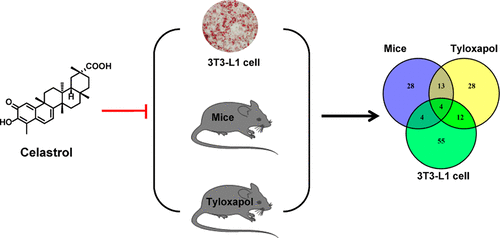当前位置:
X-MOL 学术
›
J. Proteome Res.
›
论文详情
Our official English website, www.x-mol.net, welcomes your
feedback! (Note: you will need to create a separate account there.)
Modulation of Lipid Metabolism by Celastrol.
Journal of Proteome Research ( IF 3.8 ) Pub Date : 2019-02-12 , DOI: 10.1021/acs.jproteome.8b00797 Ting Zhang 1, 2 , Qi Zhao 1, 2 , Xuerong Xiao 1 , Rui Yang 1, 2 , Dandan Hu 1 , Xu Zhu 1, 2 , Frank J Gonzalez 3 , Fei Li 1, 4
Journal of Proteome Research ( IF 3.8 ) Pub Date : 2019-02-12 , DOI: 10.1021/acs.jproteome.8b00797 Ting Zhang 1, 2 , Qi Zhao 1, 2 , Xuerong Xiao 1 , Rui Yang 1, 2 , Dandan Hu 1 , Xu Zhu 1, 2 , Frank J Gonzalez 3 , Fei Li 1, 4
Affiliation

|
Hyperlipidemia, characterized by high serum lipids, is a risk factor for cardiovascular disease. Recent studies have identified an important role for celastrol, a proteasome inhibitor isolated from Tripterygium wilfordii Hook. F., in obesity-related metabolic disorders. However, the exact influences of celastrol on lipid metabolism remain largely unknown. Celastrol inhibited the terminal differentiation of 3T3-L1 adipocytes and decreased the levels of triglycerides in wild-type mice. Lipidomics analysis revealed that celastrol increased the metabolism of lysophosphatidylcholines (LPCs), phosphatidylcholines (PCs), sphingomyelins (SMs), and phosphatidylethanolamines (PEs). Further, celastrol reversed the tyloxapol-induced hyperlipidemia induced associated with increased plasma LPCs, PCs, SMs, and ceramides (CMs). Among these lipids, LPC(16:0), LPC(18:1), PC(22:2/15:0), and SM(d18:1/22:0) were also decreased by celastrol in cultured 3T3-L1 adipocytes, mice, and tyloxapol-treated mice. The mRNAs encoded by hepatic genes associated with lipid synthesis and catabolism, including Lpcat1, Pld1, Smpd3, and Sptc2, were altered in tyloxapol-induced hyperlipidemia, and significantly recovered by celastrol treatment. The effect of celastrol on lipid metabolism was significantly reduced in Fxr-null mice, resulting in decreased Cers6 and Acer2 mRNAs compared to wild-type mice. These results establish that FXR was responsible in part for the effects of celastrol in controlling lipid metabolism and contributing to the recovery of aberrant lipid metabolism in obesity-related metabolic disorders.
中文翻译:

Celastrol对脂质代谢的调节。
高血脂症以高血脂为特征,是心血管疾病的危险因素。最近的研究已经确定了Celastrol的重要作用,celastrol是从雷公藤中分离出的蛋白酶体抑制剂。F.,与肥胖有关的代谢紊乱。然而,celastrol对脂质代谢的确切影响仍然未知。Celastrol抑制了3T3-L1脂肪细胞的终末分化,并降低了野生型小鼠中甘油三酸酯的水平。脂质组学分析显示,Celastrol增加了溶血磷脂酰胆碱(LPCs),磷脂酰胆碱(PCs),鞘磷脂(SMs)和磷脂酰乙醇胺(PEs)的代谢。进一步地,Celastrol逆转了由泰洛沙泊诱导的高脂血症,后者与血浆LPC,PC,SM和神经酰胺(CM)升高有关。在这些脂质中,LPC(16:0),在培养的3T3-L1脂肪细胞,小鼠和泰洛沙泊治疗的小鼠中,celastrol还可降低LPC(18:1),PC(22:2/15:0)和SM(d18:1/22:0)。由肝脂质合成和分解代谢相关基因(包括Lpcat1,Pld1,Smpd3和Sptc2)编码的mRNA在泰洛沙泊诱导的高脂血症中发生了改变,并通过Celastrol处理显着恢复。与野生型小鼠相比,在Fxr无效的小鼠中,celastrol对脂质代谢的影响显着降低,导致Cers6和Acer2 mRNA降低。这些结果表明,FXR部分负责Celastrol在控制脂质代谢中的作用,并有助于恢复与肥胖有关的代谢性疾病中异常脂质代谢。和泰洛沙泊治疗的小鼠。由肝脂质合成和分解代谢相关基因(包括Lpcat1,Pld1,Smpd3和Sptc2)编码的mRNA在泰洛沙泊诱导的高脂血症中发生了改变,并通过Celastrol处理显着恢复。与野生型小鼠相比,在Fxr无小鼠中,celastrol对脂质代谢的影响显着降低,从而导致Cers6和Acer2 mRNA降低。这些结果表明,FXR部分负责Celastrol在控制脂质代谢中的作用,并有助于恢复与肥胖有关的代谢性疾病中异常脂质代谢。和泰洛沙泊治疗的小鼠。由肝脂质合成和分解代谢相关基因(包括Lpcat1,Pld1,Smpd3和Sptc2)编码的mRNA在泰洛沙泊诱导的高脂血症中发生了改变,并通过Celastrol处理显着恢复。与野生型小鼠相比,在Fxr无小鼠中,celastrol对脂质代谢的影响显着降低,从而导致Cers6和Acer2 mRNA降低。这些结果表明,FXR部分负责Celastrol在控制脂质代谢中的作用,并有助于恢复与肥胖有关的代谢性疾病中异常脂质代谢。并经天青石处理后显着恢复。与野生型小鼠相比,在Fxr无小鼠中,celastrol对脂质代谢的影响显着降低,从而导致Cers6和Acer2 mRNA降低。这些结果表明,FXR部分负责Celastrol在控制脂质代谢中的作用,并有助于恢复与肥胖相关的代谢异常的脂质代谢异常。并经天青石处理后显着恢复。与野生型小鼠相比,在Fxr无小鼠中,celastrol对脂质代谢的影响显着降低,从而导致Cers6和Acer2 mRNA降低。这些结果表明,FXR部分负责Celastrol在控制脂质代谢中的作用,并有助于恢复与肥胖相关的代谢异常的脂质代谢异常。
更新日期:2019-02-13
中文翻译:

Celastrol对脂质代谢的调节。
高血脂症以高血脂为特征,是心血管疾病的危险因素。最近的研究已经确定了Celastrol的重要作用,celastrol是从雷公藤中分离出的蛋白酶体抑制剂。F.,与肥胖有关的代谢紊乱。然而,celastrol对脂质代谢的确切影响仍然未知。Celastrol抑制了3T3-L1脂肪细胞的终末分化,并降低了野生型小鼠中甘油三酸酯的水平。脂质组学分析显示,Celastrol增加了溶血磷脂酰胆碱(LPCs),磷脂酰胆碱(PCs),鞘磷脂(SMs)和磷脂酰乙醇胺(PEs)的代谢。进一步地,Celastrol逆转了由泰洛沙泊诱导的高脂血症,后者与血浆LPC,PC,SM和神经酰胺(CM)升高有关。在这些脂质中,LPC(16:0),在培养的3T3-L1脂肪细胞,小鼠和泰洛沙泊治疗的小鼠中,celastrol还可降低LPC(18:1),PC(22:2/15:0)和SM(d18:1/22:0)。由肝脂质合成和分解代谢相关基因(包括Lpcat1,Pld1,Smpd3和Sptc2)编码的mRNA在泰洛沙泊诱导的高脂血症中发生了改变,并通过Celastrol处理显着恢复。与野生型小鼠相比,在Fxr无效的小鼠中,celastrol对脂质代谢的影响显着降低,导致Cers6和Acer2 mRNA降低。这些结果表明,FXR部分负责Celastrol在控制脂质代谢中的作用,并有助于恢复与肥胖有关的代谢性疾病中异常脂质代谢。和泰洛沙泊治疗的小鼠。由肝脂质合成和分解代谢相关基因(包括Lpcat1,Pld1,Smpd3和Sptc2)编码的mRNA在泰洛沙泊诱导的高脂血症中发生了改变,并通过Celastrol处理显着恢复。与野生型小鼠相比,在Fxr无小鼠中,celastrol对脂质代谢的影响显着降低,从而导致Cers6和Acer2 mRNA降低。这些结果表明,FXR部分负责Celastrol在控制脂质代谢中的作用,并有助于恢复与肥胖有关的代谢性疾病中异常脂质代谢。和泰洛沙泊治疗的小鼠。由肝脂质合成和分解代谢相关基因(包括Lpcat1,Pld1,Smpd3和Sptc2)编码的mRNA在泰洛沙泊诱导的高脂血症中发生了改变,并通过Celastrol处理显着恢复。与野生型小鼠相比,在Fxr无小鼠中,celastrol对脂质代谢的影响显着降低,从而导致Cers6和Acer2 mRNA降低。这些结果表明,FXR部分负责Celastrol在控制脂质代谢中的作用,并有助于恢复与肥胖有关的代谢性疾病中异常脂质代谢。并经天青石处理后显着恢复。与野生型小鼠相比,在Fxr无小鼠中,celastrol对脂质代谢的影响显着降低,从而导致Cers6和Acer2 mRNA降低。这些结果表明,FXR部分负责Celastrol在控制脂质代谢中的作用,并有助于恢复与肥胖相关的代谢异常的脂质代谢异常。并经天青石处理后显着恢复。与野生型小鼠相比,在Fxr无小鼠中,celastrol对脂质代谢的影响显着降低,从而导致Cers6和Acer2 mRNA降低。这些结果表明,FXR部分负责Celastrol在控制脂质代谢中的作用,并有助于恢复与肥胖相关的代谢异常的脂质代谢异常。











































 京公网安备 11010802027423号
京公网安备 11010802027423号